ASRock X79 Extreme11 Review: PCIe 3.0 x16/x16/x16/x16 and LSI 8-Way SAS/SATA
by Ian Cutress on September 3, 2012 10:15 AM EST- Posted in
- Motherboards
- ASRock
- X79
- LSI
- PLX
USB Speed
For this benchmark, we run CrystalDiskMark to determine the ideal sequential read and write speeds for the USB port using our 240 GB OCZ Vertex3 SSD with a SATA 6 Gbps to USB 3.0 converter. Then we transfer a set size of files from the SSD to the USB drive using DiskBench, which monitors the time taken to transfer. The files transferred are a 1.52 GB set of 2867 files across 320 folders – 95% of these files are small typical website files, and the rest (90% of the size) are the videos used in the Sorenson Squeeze test.
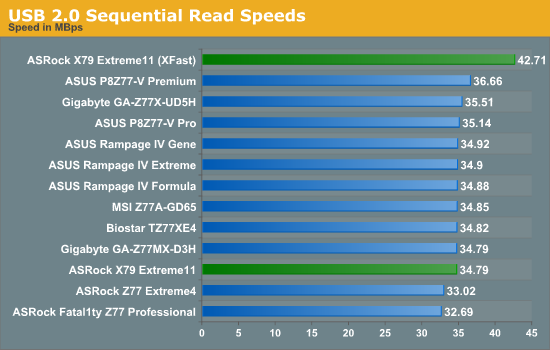
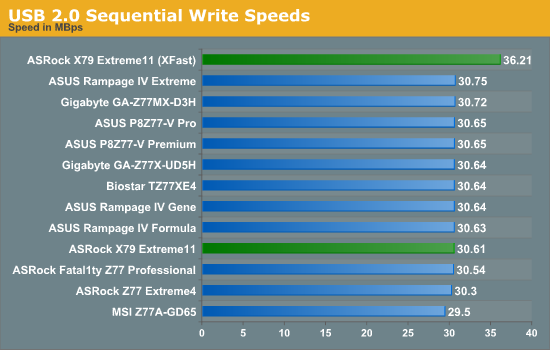
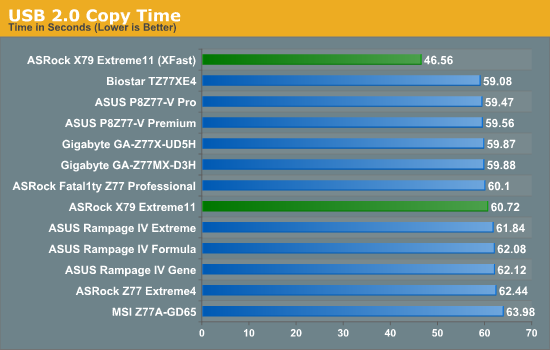
Nothing odd comes out of any USB 2.0 testing.
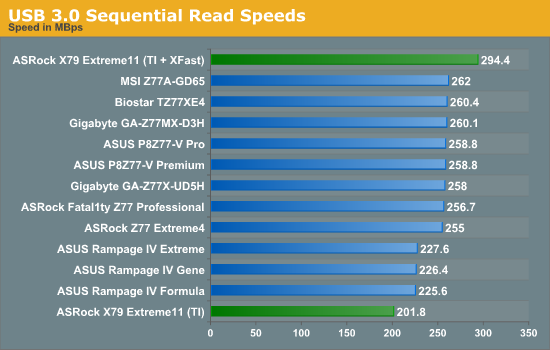
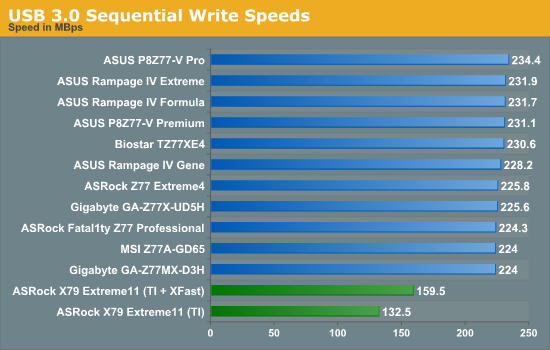
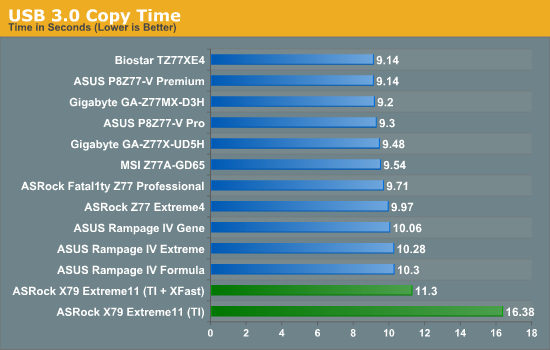
While the Z77 chipset has USB 3.0 native to the chipset, the X79 motherboards have controllers. In the case of the ASRock X79 Extreme11, we have Texas Instruments based USB 3.0 controllers, which perform rather badly in USB 3.0 writes compared to those found on the ASUS ROG boards.
SATA Testing
We also use CrystalDiskMark for SATA port testing on a C300 drive. The sequential test (incompressible data) is run at the 5 x 1000 MB level. This test probes the efficiency of the data delivery system between the chipset and the drive, or in the case of additional SATA ports provided by a third party controller, the efficiency between the controller, the chipset and the drive.
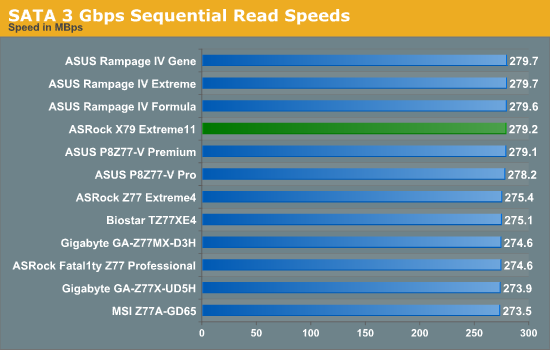
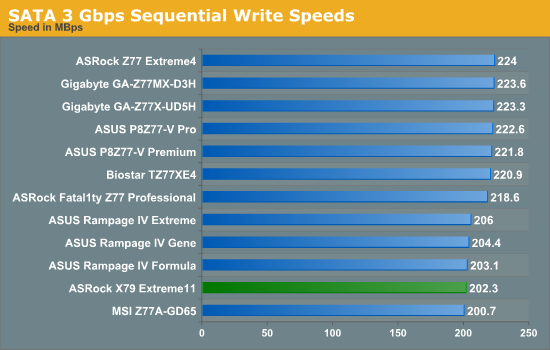
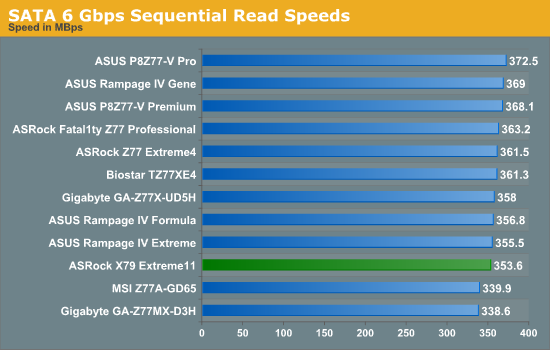
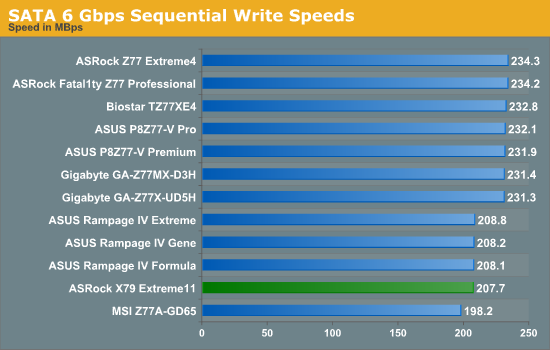
Nothing out of the ordinary comes out of our SATA testing - the SATA writing speed is split when comparing the X79 and Z77 platforms. Testing on the LSI ports will be in a later page of this review.
DPC Latency
Deferred Procedure Call latency is a way in which Windows handles interrupt servicing. In order to wait for a processor to acknowledge the request, the system will queue all interrupt requests by priority. Critical interrupts will be handled as soon as possible, whereas lesser priority requests, such as audio, will be further down the line. So if the audio device requires data, it will have to wait until the request is processed before the buffer is filled. If the device drivers of higher priority components in a system are poorly implemented, this can cause delays in request scheduling and process time, resulting in an empty audio buffer – this leads to characteristic audible pauses, pops and clicks. Having a bigger buffer and correctly implemented system drivers obviously helps in this regard. The DPC latency checker measures how much time is processing DPCs from driver invocation – the lower the value will result in better audio transfer at smaller buffer sizes. Results are measured in microseconds and taken as the peak latency while cycling through a series of short HD videos - under 500 microseconds usually gets the green light, but the lower the better.
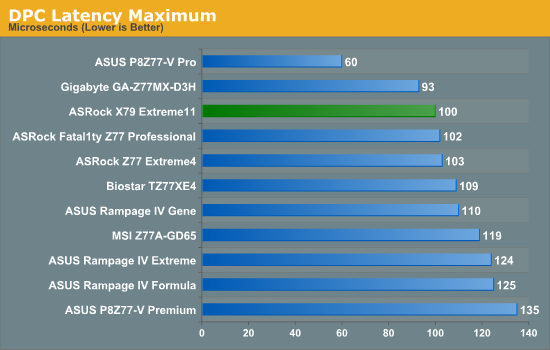
ASRock have a good standing in our DPC testing, and the X79 Extreme11 is no different. It comes in at 100 microseconds, well below the 500 microsecond ceiling or 200 microsecond recommended minimum.










62 Comments
View All Comments
sor - Tuesday, September 4, 2012 - link
Yeah, server guys know that's standard. These chips are nice for external JBODs for things like ZFS, and for simple redundancy levels. Quite often, however, when they're on the motherboard there's a header and module you can purchase/install to enable RAID5.Snuddi - Monday, September 3, 2012 - link
Please performe some RAID10 benchmarks on this. As I have read acorss forums the RAID10 results are horrible (I have tried this on my own also).With 8x 1TB disk's in RAID10 I get simuar speed as a single HDD.
So it would be great if you could test this in your test system. If numbers are horrible as I belive they will be, then AsRock will have some pressure on fixing that.
blacksun1234 - Tuesday, September 18, 2012 - link
Please enable "Disk Cache Policy" in LSI MegaRAID utility and test again. It improve a lot.yahodahan - Monday, September 3, 2012 - link
Anandtech is a great review site, but there really needs to be a properly useful benchmark here.We're talking about a board that is built for massive GPU compute, so how about an actual GPU compute benchmark? Otherwise, this review has a massive, massive hole in it.
Blender is free. Cycles is free. They have benchmark files ready to open and click "run", it's not a big hassle. And it will push every single GPU to 100%, thrash this board in a real test, and give us (people who intend to actually use the board for real GPU work, as it was intended), the data we need most.
There's so much detailed info in this article, and I appreciate that, but it's honestly missing the most important part, it would be great to see a proper follow-up/etc to fix this.
cjb110 - Tuesday, September 4, 2012 - link
Blender might be free, but time isn't! Even if they ran the test, a single number on its own would be useless...esp to the general reader.It was mentioned in the review that this product is a little out of the norm for their testing.
But it is handled consistent with their other reviews, which makes more sense, than running a bunch of tests with no comparison points.
If you want a specialised review for the boards target market I'm sure they're out there.
But maybe Blender could be included in the standard test suite, could cut down the number of game tests (these don't seem to differ much between boards).
yahodahan - Tuesday, September 4, 2012 - link
Sure, but that's the point: a review like this should take the time to focus directly on what actually matters, and in this case that is GPU compute performance (and RAID, for others).This board is a specialty case, and should be treated as such. Drop in 4 GPU's at x16 each, then 6 at x8, and do a render to see if there is a difference.
Then, test on a board with two "real" (non PLEX) x16 slots, and see if there is a difference vs 2 x16 on this boards "multiplied" channels.
This would give some numbers that are really, truly meaningful. Yes, it would take time, but why was time taken to benchmark it on games/etc, when it's been shown time and again that those numbers simply don't change and mean practically nothing?
What I'm trying to say is, this board is for a niche market- so please, test it for that niche market, not for the general masses that will never, ever use it.
ggathagan - Wednesday, September 5, 2012 - link
There's the very real possibility that Ian doesn't have 4 GPU's to test with.error451 - Wednesday, September 5, 2012 - link
Then whats the point of testing the board if your not going to benchmark its main selling points and features? This is a specialized motherboard that should have had a specialized review. Just running their standard game and video encoding benchmarks is a waste.This issue pops up every time Anandtech does a review of a non gamer/mass market product. They tell you about all the cool features and then run their standard review suite.
MadMan007 - Monday, September 3, 2012 - link
Know what makes this motherboard so great? It goes to 11!gkatz - Monday, September 3, 2012 - link
Can someone explain to me under what circumstances you might need 22 USB ports?